
The 4″/50 caliber gun was the standard low-angle, quick-firing gun for United States, first appearing on the monitor Arkansas and then used on "Flush Deck" destroyers through World War I and the 1920s. It was also the standard deck gun on S-class submarines, and was used to rearm numerous submarines built with 3-inch (76 mm) guns early in World War II. United States naval gun terminology indicates the gun fired a projectile 4 inches in diameter, and the barrel was 50 calibers long.

The 16"/50 caliber Mark 2 gun and the near-identical Mark 3 were guns originally designed and built for the United States Navy as the main armament for the South Dakota-class battleships and Lexington-class battlecruisers. The successors to the 16"/45 caliber gun Mark I gun, they were at the time among the heaviest guns built for use as naval artillery.

The 6"/53 caliber gun formed the main battery of some United States Navy light cruisers and three US submarines built during the 1920s.
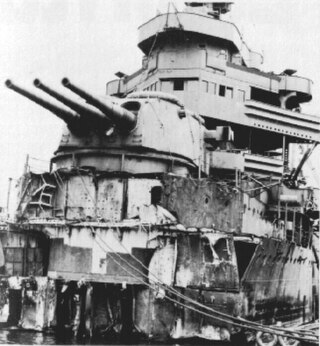
The 8"/55 caliber gun formed the main battery of United States Navy heavy cruisers and two early aircraft carriers. United States naval gun terminology indicates the gun barrel had an internal diameter of 8 inches (203 mm), and the barrel was 55 calibers long.

The 8"/30 caliber gun formed the main batteries of the United States Navy's "New Navy". They were a US naval gun that first entered service in 1886, and were designed for use with the first three protected cruisers, Atlanta, Boston and Chicago.
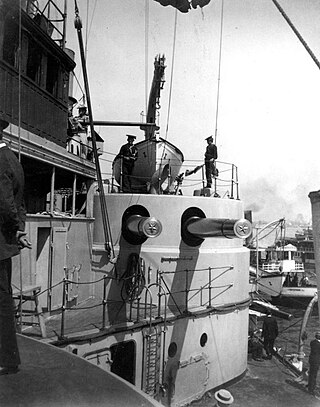
The 8"/35 caliber gun Mark 3 and Mark 4 were used for the main batteries of the United States Navy's first armored cruisers and the secondary batteries for their first battleships, the Indiana-class. The 8"/40 caliber gun Mark 5 initially armed the Pennsylvania-class armored cruisers.

The 10"/31 caliber gun Mark 1 Mod 1 and the 10"/35 caliber gun Mark 1 Mod 2 were both used for the primary batteries of the United States Navy's Amphitrite-class monitor Miantonomoh. The 10"/30 caliber gun Mark 2 was used as main armament on the remaining Amphitrite-class monitors, the monitor Monterey, and the armored cruiser Maine.

The 12"/35 caliber gun were used for the primary batteries of the United States Navy's "New Navy" monitors Puritan and Monterey and the battleships Texas and Iowa.

The 8"/45 caliber Mark 6 gun were used for the secondary batteries of the United States Navy's last pre-dreadnought battleships and refitted in older armored cruisers main batteries.

The 12"/40 caliber gun were used for the primary batteries of the United States Navy's last class of monitors and the Maine-class and Virginia-class pre-dreadnought battleships.

The 10"/40 caliber gun Mark 3 was used for the main batteries of the United States Navy's last generation of armored cruisers, the Tennessee-class. The Mark 3s were the last, and most powerful, 10-inch (254 mm) guns built for the US Navy.

The 6"/40 caliber gun Mark 4 were used for the secondary batteries of the United States Navy's Indiana-class and Illinois-class battleships. They were also used as the main battery on the Cincinnati-class protected cruisers.
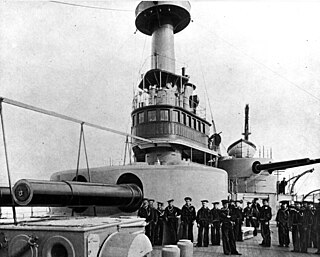
The 13"/35 caliber gun Mark 1 was used for the primary batteries on eight of the first nine battleships in the United States Navy, Indiana-class, Kearsarge-class and Illinois-class; USS Iowa (BB-4) used the 12-inch (305 mm)/35 caliber gun.

The 4"/40 caliber gun was used for the secondary batteries on the United States Navy's battleship Iowa, Columbia-class protected cruisers, and the armored cruiser New York, and was the primary batteries on the gunboats Nashville, Wilmington, and Helena.
The 5"/31 caliber gun were used in the secondary batteries of the United States Navy's "New Navy" protected cruiser Chicago and later mounted in Panther during the Spanish–American War.
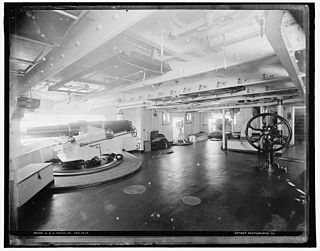
The 5″/40 caliber gun were used in the secondary batteries of the United States Navy's early battleships, armored cruisers, protected cruisers, unprotected cruisers, and auxiliary cruisers.

The 5"/50 caliber gun was the first long barrel 5-inch (127 mm) gun of the United States Navy and was used in the secondary batteries of the early Delaware-class dreadnought battleships, various protected cruisers, and scout cruisers. They were also refitted in the secondary batteries of the armored cruiser New York and the New Orleans-class protected cruisers. They were later used on cargo ships, store ships and unclassified auxiliaries during World War II as well as in emergency coastal defense batteries.
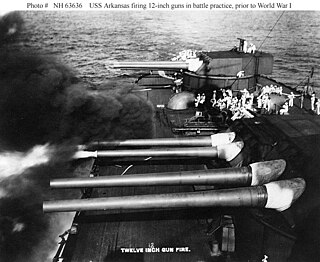
The 12"/50 caliber Mark 7 gun was a United States Navy's naval gun that first entered service in 1912. Initially designed for use with the Wyoming class of dreadnought battleships, the Mark 7 also armed the Argentine Navy's Rivadavia-class battleships.

The 6"/50 caliber gun Mark 6 and Mark 8 were used for the secondary batteries of the United States Navy's Maine-class and Virginia-class battleships, as well as the Pennsylvania-class and Tennessee-class armored cruisers. They were also used as the main battery on the St. Louis-class protected cruisers.

The Škoda 10 cm K10 was a 100 mm (3.9-inch) naval gun of the Austro-Hungarian Navy used as tertiary armament on semi-dreadnought battleships and as primary armament on scout cruisers and destroyers during World War I. After World War I, variants of the Škoda 10 cm K10 were widely produced in Italy as the 100/47 series of guns, which served in a number of roles, on a wide variety of ships, with a number of navies.



















